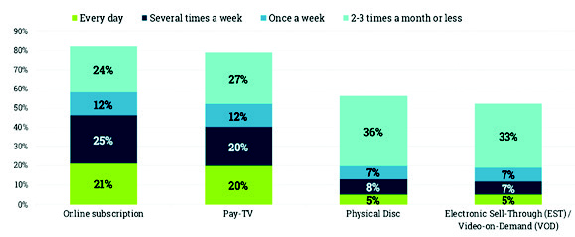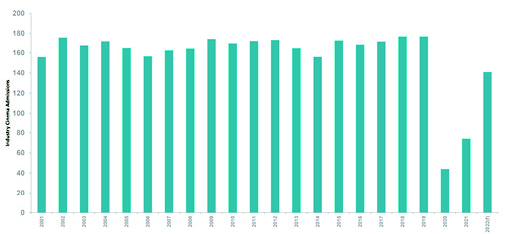Abstract
Films have become a dominant part of the entertainment industry over the years, as motion pictures was used to bring stories to life on the big screen. An array of stories developed through the change experienced by individuals within the world. It became a medium to disseminate news and ideas into societies. Although the covid-19 pandemic forced cinemas to close because of social distancing, over the top media services (OTT) became the dominant platform for watching films. This study aims to understand the impact that films have on societies and if it can change attitudes of people watching the film.
Results have identified that films are a powerful tool through which attitudes of individuals in societies can be altered. There is a relationship between the attitudes of people within societies and mass media image of reality. Positive and negative impacts on individuals are discussed within this research paper. Films are a multipurpose tool used within societies in contemporary life.
Although film is a form of escapism, they have influenced societies through politics, law, culture, and have the power to change the path of contemporary life and create history. Films shape the way the youth perceive the world; they provide a foundation for the seeds of hope or doubt flourish, through which they can contribute to the future of an individual. Therefore, steps must be taken to restrict misinformation within films that can have a negative societal impact and ruin lives of individuals in the future.
Introduction
The primary goal of the cinematic art form is to send a message and create an impact. Technology has been advancing within contemporary life and it has been adopted to its optimum by the film industry. 2D, 3D and 4D cinema uses technology to its optimum, inviting viewers to lose themselves within another world. However, within history numerous leaders have utilised the platform of films to reach their goals.
This can stem back to world war I when political leaders of the time for example Adolf Hitler and Stalin successfully utilised films as a form of propaganda (Boy, 2017).
Films have become a dominant part of the entertainment industry over the years, as motion pictures was used to bring stories to life on the big screen. An array of stories developed through the change experienced by individuals within the world. It became a medium to disseminate news and ideas into societies. Although the covid-19 pandemic forced cinemas to close because of social distancing, over the top media services (OTT) became the dominant platform for watching films. Within March 2022 it was revealed by Motion Picture Association (MPA), that people within America were most likely to watch movies within their homes via online subscription services opposed to Pay TV. Figure 1 illustrates the number of US adults watching films by home or mobile distribution channels published by motion pictures association (MPA, 2022).

Although individuals have been conditioned to watching films at home due to closures during the pandemic, according to figure 2 published by digital cinema media, cinema attendance is expected to continue rising to reach 80% of the record breaking 2019 admission rates.

Objectives
This study aims to understand the impact that films have on societies and if it can change attitudes of people watching the film. A review of literature has conducted within this study.
Results and Discussion
Results have identified that films are a powerful tool through which attitudes of individuals in societies can be altered. Positive and negative impacts on individuals are discussed within this research paper. Films are a multipurpose tool used within societies in contemporary life. The freedom of expression has resulted in diverse films being made through which direct and indirect messages are shared to either positively or negatively influence global societies.
Negative influences
According to a meta-analysis of studies, it has been revealed that there is a relationship between the attitudes of people within societies and mass media image of reality (Morgan & Shanahan, 1997). It is challenging to identify single mechanisms of mass media that have an impact upon human behaviour and related thinking (Latynov, 2013).
The series on the OOT platform ‘Netflix’ called ‘The Crown’ is based on the life of Queen Elizabeth the British Monarch who reigned until 2022. Although the primary material is factual as viewers learn about history, politics within the UK during 1960-1970, there are elements of the series that is fictional, because it is not a documentary. It is a work of fiction based on real live events (Hallemann, 2022). However, if audiences do not have factual knowledge about events that happened within the Royal family, it is difficult to gage what is true. The misinformation formed within the minds of viewers can portray some individuals in a negative light and contribute towards individuals in global societies forming negative perceptions and tarnishing images of certain individuals. In addition, other films that were released in the cinema after global tragic events like the 9/11 terrorist attack, enticed viewers to watch potential conspiracies acted out on the big screen. Despite the reality of truths, negative perceptions of different religions and communities around the world can be formed. Such cinema can lead to racism and hostile behaviour towards innocent members of societies.
Films create images of different countries to either generate interest or deter individuals from visiting there, having the ability to increase or decrease revenue attached to economic growth through tourism. Hence, film can shape ideas in the minds of young viewers that have never visited particular countries or had exposure to various cultures (Kubrak, 2020). Thus, films and series watched for casual viewing has the power to influence mindsets, particularly if individuals are younger and more impressionable and do not have the motivation to find out the truth about such events. When films identify with the emotions of the individual watching the film despite if the film was violent, happy, or scary, viewers tend to be engrossed within the story. This leaves a favourable impression of the places featured within the film (Yang & Bergh, 2017).
Positive influences
Movies can evoke different emotions, through dialogue, music and picture. They can promote knowledge and present ideas to individuals through dramatic or humorous scenes that connect with audiences. Films are largely watched for entertainment purposes, where individuals choose to escape from the reality of their world and enter in a fantasy world that they do not have any connection to. They are on-lookers and in a very relaxed state of mind which allows them to absorb the content of what is being shown. It has been proven within studies that individuals are able to retain more information when they are in a relaxed mind state (Kelland, 2010). Therefore, well written dialogues and delivery within the film can create an impact upon audiences. It can provide them with thought provoking ideas that can be implemented within contemporary life. For example, when a film is dramatic it can teach the adolescence about social interaction with adults and the opposite sex (Valkenburg & Cantor, 2001). In addition, films can change the mood of individuals and change the world. Although it is a form of escapism, films have influenced societies through politics, law, culture, they have the power to change the path of contemporary life and create history. Film is a form of art which can create an emotional attachment and reveal individual vulnerabilities silently. It can also change individual opinions and life perceptions. Research has revealed that films can influence people’s opinions, stereotypes, beliefs, and attitudes, in addition to ethic and gender stereotypes
(Behm-Morawitz & Mastro, 2008). Thus, it has the power to change attitudes towards various groups of people and can create new opinions that can be adopted by individuals watching the film.
Films can have a positive impact upon individual’s self-concept (Sobkin & S, 2010). While it has also been proven to help individuals understand other people and improve ethnic tolerance rates
(Andreeva & Bogdanova, 2017). The amount it impacts a person is dependent upon the individual and the film itself. When an individual watches a film, they are affected at some point and in some way. Due to the large societal interest in films, it can impact and influence global societies in positive and negative ways.
Conclusion
Films are very powerful mediums through which individuals can be influenced, in negative and positive ways. How effective the impact is on the individual, is determined by what direction it is travelling in, for example, changing the human behaviour is more difficult than influencing individual opinions and attitudes (Harris, 2002). They can facilitate societal growth economically, socially and to a certain extent politically. When films possess accurate information, it can expand an individual’s knowledge base and view the situations, cultures, and different scenarios through another perspective. In contrast, films can also promote bad habits, violence and send negative messages to the public. Therefore, this study has established a dual impact upon societies. Films shape the way the youth perceive the world; they provide a foundation for seeds of hope or doubt that can be flourished, potentially contributing to the future of an individual. Therefore, steps must be taken to restrict misinformation within films that can have a negative societal impact and ruin lives of individuals
It is recommended that film production companies should be mindful of the content included within films prior to release, with considerations made to the overall impact on viewers. In addition, individuals should be cautious about the films or OTT content that they decide to view. The messages taken from films should be taken with the view of researching the subject further prior to deciding or acting in a specific manor and altering a personality. Remember films are the product of individual thoughts and perspectives, thus, the content within films should not influence the personality of an individual. Films do have the power to shape modern societies around the world and if they provide positive content, they can help viewers with their personal growth and impact positive societal progression. Critical thinking skills can play big part of understanding a film; therefore, this can have a multi-dimensional impact on individuals who should be mindful not to let it change them as individuals completely.
References
- Andreeva, O., & Bogdanova, M. V. (2017). Cinema therapy as a way of forming ethnic tolerance among students. Pedag. Educ, 76–83.
- Behm-Morawitz, E., & Mastro, D. (2008). Mean girls? The influence of gender portrayals in teen movies on emerging adults’ gender-based attitudes and beliefs. Mass Commun. Q.
- Bowler, H. (2022, 01 14). 2022 cinema update. Retrieved from DCM: https://www.dcm.co.uk/up-loads/documents/1.Cinema_ Update_-_DCM.pdf
- Boy, P. (2017, 01 15). How Do Movies Affect Society? Retrieved from Our movie life: https://www.ourmoviel-ife.com/2017/01/15/how-do-mov-ies-af-
fect-society/#:~:text=However%2C%20movies%20can%20affect%20soci ety,bad%20message%20to%20the%20public. - Hallemann, C. (2022, 10 05). Is The Crown Accurate? The Answer Is Complicated. Retrieved from townandcountrymag: https://ww-w.townandcountrymag.com/lei-sure/arts-and-cul-
ture/a29873503/the-crown-netflix-t v-show-accuracy/ - Harris, R. (2002). Psychology of Mass Communications. St. Petersburg, Russia: Prime-Eurosign.
- Kelland, K. (2010, 03 24). Scientists find how relaxed minds remember better. Retrieved from reuters: https://www.reuters.com/arti-cle/us-memory-brainwaves-idUS-TRE62N4VJ20100324
- Kubrak, T. (2020). Impact of Films: Changes in Young People’s Attitudes after Watching a Movie. Behavioral sciences.
- Latynov, V. (2013). Psychology of Communicative Impact. Moscow, Russia: Institute of Psychology of RAS.
- Morgan, M., & Shanahan, J. (1997). Two decades of cultivation research: An appraisal and
meta-analysis. In B. B.R, & K. A.W, Communication Yearbook (pp. 1-47). Thousand Oaks, CA, USA: Sage Publications. - MPA. (2022, 03 29). People Are Watching Movies More Frequently Through Streaming Subscriptions Than Pay-TV. Retrieved from Marketing Charts: https://ww-
w.marketingcharts.com/indus-tries/media-and-enter-
tainment-225265 - Sobkin, V. S., & S, M. O. (2010). The Film “Scarecrow” through the Eyes of Modern Students. Works on the Sociology of Education. Moscow, Russian: Institute of Sociology of Education of RAO.
- Valkenburg, P. M., & Cantor, J.(2001). The development of a child into a consumer. J. Appl. Dev. Psychol.
- Yang, F., & Bergh, B. (2017). Movies Influence on Country Concept. In F. J.A., & K. A, Shaping International Public Opinion A Model for Nation Branding and Public Diplomacy (pp. 113–133). New York, NY, USA: Peter Lang.
DOI
https://doi.org/10.57259/GRJ6673
Research Objectives
- To understand the impact that films have on societies.
- Can films change attitudes of people watching it.
Bio

Junmoni Gogoi is a Film and Media Researcher. She is also a Professional Model, Mrs India SG 2021 & Winner of Dada Saheb Phalke Fashion and Lifestyle Award 2021.
